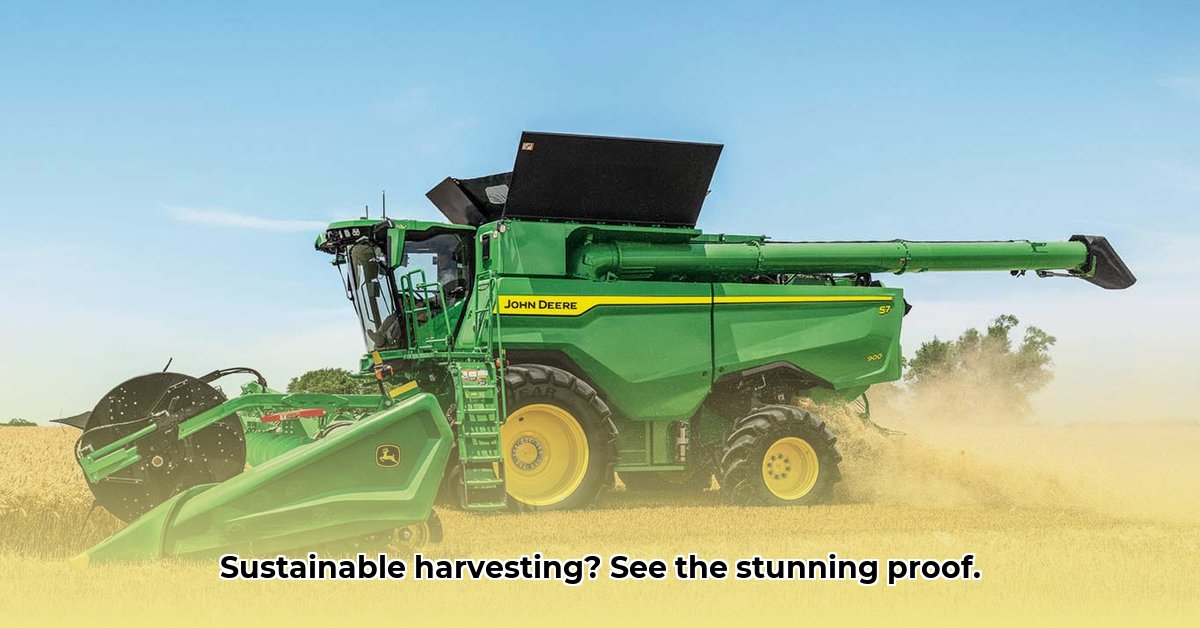
Combine Tractor Pictures: A Glimpse into Sustainable Harvesting
Combine harvester pictures often showcase impressive machinery, but these powerful tools represent more than just metal and engineering. They symbolize a critical component of our global food system, and their usage is undergoing a significant transformation toward sustainability. For more detailed information on combine harvesters, visit this helpful resource. This article explores the innovative technologies revolutionizing combine harvesting, examining their environmental impact and outlining actionable steps toward a more sustainable future.
The Modern Combine: A Technological Marvel
Modern combines are far larger and more automated than their predecessors. They are essentially high-tech robots harvesting crops at incredible speeds, requiring less labor and accelerating harvest times. However, advancements extend beyond sheer size. GPS guidance systems and automated controls are increasingly prevalent, enhancing precision and minimizing waste. This precision agriculture approach delivers greater yields and a more efficient harvest. But this efficiency comes at a cost.
The Environmental Impact: Thinking Beyond the Harvest
While highly efficient, traditional combine harvesters have a substantial environmental footprint. High fuel consumption leads to significant greenhouse gas emissions, contributing to climate change. Furthermore, their weight compacts soil, harming its structure and long-term health. This highlights the crucial need to balance the need for food production with the preservation of our planet's resources. How can we maximize yields while minimizing environmental damage?
Sustainable Solutions: Innovations in the Field
The agricultural industry is actively addressing these challenges. Manufacturers are developing more fuel-efficient engines, exploring alternative fuels, and integrating advanced technologies. Reduced-impact tires are designed to minimize soil compaction; precision agriculture techniques optimize harvesting routes via GPS and yield mapping, further reducing fuel consumption and soil disturbance. The overarching goal is to maximize yields while minimizing the environmental impact.
Key Advancements Toward Sustainable Harvesting
Several key technologies are driving this transition:
Fuel Efficiency: Engine design improvements and alternative fuel sources are significantly reducing fuel consumption, resulting in less pollution and lower operating costs.
Reduced-Impact Tires: These tires are gentler on the soil, lessening compaction and maintaining soil health for years to come.
Precision Agriculture: GPS and yield mapping optimize harvesting routes, minimizing unnecessary passes and improving soil integrity.
Automation: Automated steering, cutting, and unloading increase efficiency, reduce labor costs, and potentially minimize errors. The use of AI in image recognition is reducing wasted harvesting efforts.
The Future of Harvesting: A Glimpse into Tomorrow
The future holds even more promise. Fully autonomous harvesting guided by sophisticated AI is on the horizon. Imagine combines making real-time decisions, adapting to weather and crop density changes. This technological leap would result in unprecedented efficiency and minimal waste. The integration of renewable energy sources, like solar panels, actively reduces dependence on fossil fuels. These advancements will transform crop harvesting, creating a more sustainable and efficient agricultural future.
Actionable Steps: What We Can Do Today
For Farmers:
- Prioritize regular maintenance, optimizing engine efficiency and fuel consumption.
- Implement precision agriculture techniques to minimize wasted resources.
- Explore the feasibility and cost-effectiveness of transitioning to biofuels where applicable.
For Manufacturers:
- Invest in Research and Development for more fuel-efficient combine harvesters that utilize cleaner energy sources.
- Refine precision agriculture technology for even greater efficiency.
- Develop robust renewable energy integration systems.
For Governments and Policy Makers:
- Offer financial incentives for the adoption of sustainable technologies by farmers.
- Fund research and development in sustainable agriculture.
- Create and enforce environmentally conscious agricultural policies.
For Researchers:
- Conduct comprehensive lifecycle assessments (LCAs) to evaluate the environmental impact of various combine harvester technologies.
- Create improved predictive models for fuel consumption and emissions reduction.
- Explore new methods of integrating renewable energy sources for harvesting equipment.
Analyzing the Risks and Rewards of Sustainable Harvesting Technology
| Technology/Practice | Probability of Failure | Impact of Failure | Mitigation Strategies |
|---|---|---|---|
| Biodiesel Adoption | Medium | Higher costs; reduced performance | Secure reliable biofuel supply; conduct thorough engine compatibility testing |
| Precision Agriculture | Low | Inefficient resource use; inaccurate data | Invest in robust sensor technology; implement thorough data validation procedures |
| Renewable Energy Systems | High | System failures; high upfront investment | Design redundant systems; secure government incentives; implement a phased deployment strategy |
| Engine Technology Upgrades | Low | Higher initial purchase price | Explore leasing options; offer phased upgrade plans; provide attractive financing schemes |
This collaborative effort, involving farmers, manufacturers, governments, and researchers, is crucial to ensuring a sustainable future for agriculture and the planet. The images of combine harvesters are not just pictures of machines; they represent the ongoing commitment to feeding the world while protecting the environment.